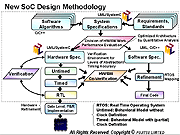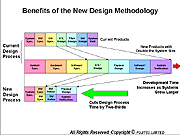 |
|
Fujitsu Limited
Fujitsu Laboratories Limited |
 |
Fujitsu Develops New SoC Design Methodology Based on
UML and C Programming Languages
--Cuts System Level to RTL Design Time by Two-thirds--
Tokyo, April 16, 2002 - Fujitsu Limited and Fujitsu Laboratories Ltd. today announced the development of new System-on-a-Chip (SoC) design methodology based on UML*1 and C*2 (C/C++/SystemC*3) programming languages. By clearly defining the SoC upstream design process-covering specification design through RTL design*4-the new methodology improves design efficiency, cutting design times for upstream processes by two-thirds compared to conventional methods.
With the development of larger scale systems with higher functionality and shorter product development cycles, the reduction of SoC development times has become a high priority. The new methodology represents an important breakthrough in the goal of reducing SoC design times.
In this new design methodology, Fujitsu introduced an object oriented*5 technique to achieve a consistent, well-defined upstream development process, from system level design to RTL design, bringing clear operating methods and procedures to a process that up until now had been subject to trial and error. Moreover, because it enables users to analyze system structure and performance, the most appropriate architecture (such as bus structure, hardware and software partitioning, etc.) can be chosen at the specification design stage, establishing a design flow that eliminates backtracking.
SystemC, which is becoming a de-facto standard in the industry, is used as the system level description language, and CWL*6, announced in January 2002, is used as the interface description language.
Fujitsu has already started using the new methodology in its own SoC development process, and the company expects to ship its first products using the methodology by the end of the year.
Fujitsu has also developed a training program for the new methodology, which the company's SoC design engineers will begin taking in May 2002.
In addition, to further improve the SoC design efficiency, Fujitsu plans to integrate this new methodology with its platform-based design methodology.
Attachments
 |
 |
| Fig. 1: New SoC Design Methodology | Fig. 2: Benefits of New Design Methodology |
- Terminology
-
- *1. UML (Unified Modeling Language)
- Modeling language being standardized by OMG (Object Management Group) for software systems. Widely used in the software industry for system modeling with object oriented analysis and design.
- *2. C Programming Language
- A widely used language for basic software programming. Became popular after being developed in the 1970s as a high-level language for use with UNIX. Today, C++ is the most widely used version.
- *3. SystemC
- System Level Description Language based on C++, being standardized by OSCI (Open SystemC Initiative). Defines the set of Class Libraries for the hardware and/or system description, within the C++ syntax.
As one of the board members of OSCI, Fujitsu is leading the standardization effort.
- *4. RTL: Register Transfer Level
- RTL is the one of the abstraction levels for describing hardware in HDL (Hardware Description Language), and widely used today due to its synthesizability. Other abstraction levels in HDL are the behavioral level (higher level of abstraction than RTL) and the gate level (lower than RTL, and final circuit netlist synthesized from RTL). The two most popular HDLs are VHDL and Verilog.
- *5. Object oriented
- One of the main development methods used in the software field, it uses the modular design of the software to improve re-usability. C++ and Java are among the object oriented programming languages used.
- *6. CWL: Component Wrapper Language
- Interface Specification Description Language for IP re-use and exchange. Its declarative and exhaustive descriptions enable users to detect interface related problems statically.
About Fujitsu
Fujitsu is a leading provider of Internet-focused information technology solutions for the global marketplace. Its pace-setting technologies, best-in-class computing and telecommunications platforms, and worldwide corps of systems and services experts make it uniquely positioned to unleash the infinite possibilities of the Internet to help its customers succeed. Headquartered in Tokyo, Fujitsu Limited (TSE:6702) reported consolidated revenues of 5.48 trillion yen for the fiscal year ended March 31, 2001. Internet:http://www.fujitsu.com/
 |
 |
[Press Contacts]
Chiaki Kuwahara, Nancy Ikehara
Fujitsu Limited, Public Relations
Tel: +81-3-3215-5259 (Tokyo)
Fax: +81-3-3216-9365
 Press Inquiries Press Inquiries
|
[Customer Contact]
Fujitsu Limited
Electronic Devices Group
System Solutions LSI Division
Tel: +81-42-532-1494 (Tokyo)
E-mail: edevice@fujitsu.com
[Technical Contact]
Fujitsu Laboratories
IT Media Lab
CAD Research Department
Tel: +81-44-754-2663 (Kawasaki)
E-mail: cedar-info@proc.flab.fujitsu.co.jp
|
 |
 |
 |
| Please
understand that product prices, specifications and other details are
current on the day of issue of the press release, however, may change
thereafter without notice. |
|



